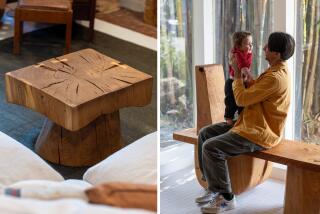âIâve always been thinking big, but getting to work this big is something that happens gradually.â --Norman Hines : Artwork the Size of Texas
Out in the wide open spaces of Arlington, Tex., where giant works of art are as scarce as Pomona College professors, a new Texas-scaled monument is being called one of the largest environmental sculptures in the Western Hemisphere.
The chairman of the company that commissioned the sculpture had never heard of Norman Hines, but spent more than $3 million on Hinesâ vision in the hope that his work would put Arlington--and a new commercial center--on the map.
Hines is back teaching at Pomona College after surpassing the developerâs hopes and budget and his own expectations.
It took the Claremont sculptor almost two years to complete Caelum Moor, an environmental sculpture composed of five massive stone arrangements, a five-acre park, a lake, a waterfall, trees and an amphitheater.
âA Passionâ
âIt was a passion for me,â said Hines as he tried to explain the pleasures of spending months in a quarry where he personally cut, carved, polished and flame-cut 550 tons of Texas pink granite.
âItâs a miracle,â said Jane Mathes Kelton, chairman of Kelton Mathes Development Corp. of Arlington, who commissioned Hinesâ work as part of the companyâs 340-acre commercial center.
âIf it had cost $5 million, we would have found the money somehow, and it would have been worth it.â
Hines, 47, took a 1 1/2-year leave from Pomona College in 1984 to work on the sculpture. He spent most of that time working from dawn to dark carving stone in the quarry in Marble Falls, a small town 200 miles from Arlington. It was a radical departure from teaching sculpture and ceramics and beyond the scope of anything he had ever done.
Thinking Big
âIâve always been thinking big, but getting to work this big is something that happens gradually,â Hines said. âProjects like this are incredibly rare.â
Until Caelum Moor, he said, his largest work was a fountain eight feet high and 18 feet across at Chapman College in Orange.
Hines said he came upon the Texas project by accident more
than two years ago. While en route to England to see Stonehenge and other ancient megaliths, he stopped in Dallas for a few days to propose a sculpture for a Dallas building.
He did not get the commission, but he learned through the buildingâs developer that Kelton Mathes in nearby Arlington wanted a major sculpture as a focal point for the Highlands, a commercial center with office buildings, retail space, restaurants and theaters that will take an estimated 15 years to complete.
âGod Sends Me Peopleâ
Kelton told Hines she wanted standing stones reminiscent of Stonehenge. Hines told Kelton he just happened to be on his way to England to study them.
âGod sends me people,â Kelton said. âNorm walked in the door that day, and we never talked to another sculptor. I just feel enormously privileged that this magic happened, and his name is Norman Hines.â
The artist and patron were in complete artistic accord, both said. They agreed that the megaliths would tie nature and an ancient heritage to the high-tech community that will build up around them.
Hines found a quarry with the granite he wanted, chose the solid block from which all the stones were cut, carved their designs and flame-cut every surface himself.
Acting as Supervisor
He supervised the drilling and placing of 53-foot-deep concrete footings that had to be sunk into bedrock in the Arlington park to support the stonesâ massive weight.
He arranged for the transportation of the stones from the quarry to Arlington on 16 huge trucks and their placement on the footings by cranes. One of the stone groupings is 34 feet tall, the height of a three-story building.
Caelum is a reference to a remote constellation known as the âsculptorâs tool,â and moor refers to the windswept plains of Scotland. He gave each grouping a Celtic name as a tribute to the standing stones of the British Isles and to the Mathes Kelton family heritage. The groupings of stone sculpture are called Morna Linn, Sarsen Caer, DeâDanann, Tolmen Barrow and Tan Tara.
They are placed so that not all can be seen from any single position, requiring the viewer to walk through the park.
Echo Chamber
Tan Tara, the tallest, serves as a natural echo chamber. Only a person standing between its two pillars, connected by a crossbar on top, can hear the echo. Morna Linn stands in the lake with a fountain between its two pillars and the three stones of Sarsen Caer form a semi-circle that is a backdrop for the amphitheater. Tolmen Barrow is three low stones in straight line and DeâDanann is three tall stones in a triangle.
The sculptor supervised the movement of 37,000 cubic yards of earth to make gentle slopes and an amphitheater in the park and the drilling of two wells to form the lake.
He had water pumped to the top of one megalith where it becomes a waterfall, and ordered a computerized lighting system. Then he went into horticulture, choosing deciduous trees that would constantly change color and form, native wildflowers and Bermuda grass.
In the process, Hinesâ costs steadily rose from the $250,000 that Kelton Mathes originally planned to spend, to $1 million that was budgeted and finally to more than $3 million.
âHeart in My Throatâ
âI got my heart in my throat a few times because of course the (real estate) market is terrible in Texas,â Kelton said. âMy company is only 4 years old and this was an enormous step, but Iâll never regret it. Caelum Moor is a special place.â
Her son, Andrew Kelton, president of the development company, said, âIt started to be a little thing, and when you see the little models it doesnât really hit you. But to walk in that park, itâs really staggering. No one has a mother as crazy as mine, and I donât know many sculptors who would do this. Others would just design it and send it out for workmen to finish.â
The completed sculpture, both said, is a work of art that fulfills their highest hopes and gives an identity to Arlington, a bedroom community midway between Dallas and Fort Worth. It has received some favorable local reviews and is getting nationwide recognition through several magazine articles.
âPeople love it,â Jane Kelton said. âThe public is a hell of a lot smarter and more sophisticated than we think, and people just kind of got it--they grasped what it was about. Itâs being used as a setting for fashion ads, theater productions, and weâre getting wedding requests. Itâs terribly exciting.â
Not Rich but Famous
Hines declined to say how much money he earned from the sculpture, but said, âI definitely did not get rich.â
âNorm will never be rich but he will be famous,â Kelton said.
Now back home, Hines lives and does his private work in a studio he built in an industrial section of Pomona near Claremont. It abounds with sculpture, both finished and in progress, most of it abstract stone carvings. There are other art works, books, music, drafts and drawings for proposed works, and photographs, mostly of his grown daughters, Elizabeth, Katherine and Sarah.
A native New Yorker, Hines first entered Pomona College as a student in 1956 and graduated with a degree in English literature. He earned a master of fine arts degree from Claremont Graduate School and has taught swimming, water polo and art at Scripps and Pomona Colleges.
For five years in the 1960s he was an administrator and teacher in prep schools on Santa Catalina Island and in Los Olivos.
He returned to Pomona College as assistant dean of admissions and teacher f ceramics, but later gave up the administrative position to teach art full time.
Parts of the Whole
He sees no contradictions in the variety of his careers.
âI donât separate those things--athletics, teaching and art are all part of me and they all reflect each other,â he said. âI think teaching forces me to constantly re-evaluate my ideas and concepts. Students challenge you and want to know why, so I constantly have to re-examine what Iâm doing and I find that stimulating.â
Hines has had several major exhibits throughout Southern California and has been commissioned to do several private artworks.
âI have a hard time fixing on the concept that Iâve done something that will last,â he said. âI like the process of creating as much as the finished product, and I missed it when it was done.â
The Keltons have formed a foundation that will maintain Caelum Moor because, the developer said, âWeâre not changing one blade of grass. Andrew and I have said that when we die, cremate us and throw our ashes in the lake.â
Hines said he is pleased with the reception his masterwork is getting.
âI hope they like it, because theyâd have a hell of a time getting rid of it.â


